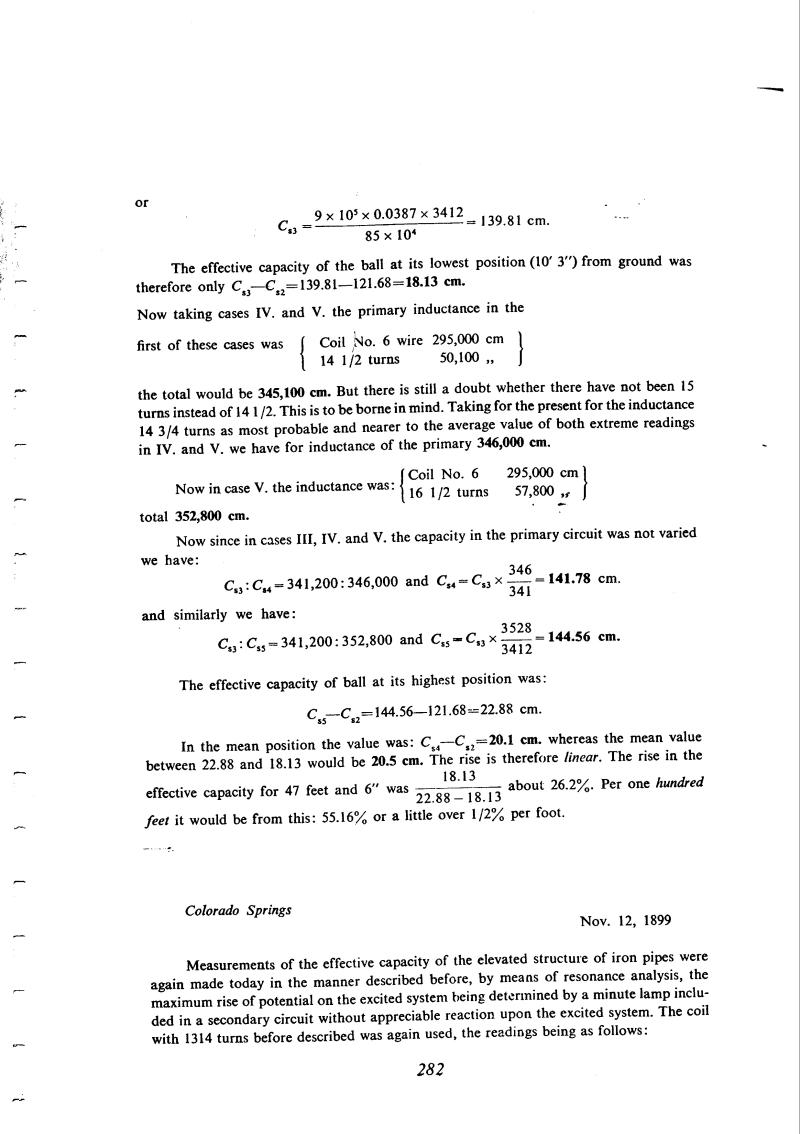
Nikola Tesla Books
or
Cs3 = $! {{9 \times 10^{5} \times 0.0387 \times 3412} \over {85 \times 10^{4}}} $! = 139.81 cm.
The effective capacity of the ball at its lowest position (10' 3") from ground was therefore only Cs3 - Cs2 = 139.81 - 121.68 = 18.13 cm.
Now taking cases IV. and V. the primary inductance in the
| first of these cases was | { | Coil No. 6 wire | 295,000 cm | } |
| 14 1/2 turns | 50,100 " |
the total would be 345,100 cm. But there is still a doubt whether there have not been 15 turns instead of 14 1/2. This is to be borne in mind. Taking for the present for the inductance 14 3/4 turns as most probable and nearer to the average value of both extreme readings in IV. and V. we have for inductance of the primary 346,000 cm.
| Now in case V. the inductance was: | { | Coil No. 6 wire | 295,000 cm | } |
| 16 1/2 turns | 57,800 " |
total 352,800 cm.
Now since in cases III, IV. and V. the capacity in the primary circuit was not varied we have:
Cs3:Cs4 = 341,200:346,000 and Cs4 = Cs3 x $! {346 \over 341} $! = 141.78 cm.
and similarly we have:
Cs3:Cs5 = 341,200:352,800 and Cs5 = Cs3 x $! {3528 \over 3412} $! = 144.56 cm.
The effective capacity of ball at its highest position was:
Cs5 - Cs2 = 144.56 - 121.68 = 22.88 cm.
In the mean position the value was: Cs4 - Cs2 = 20.1 cm. whereas the mean value between 22.88 and 18.13 would be 20.5 cm. The rise is therefore linear. The rise in the effective capacity for 47 feet and 6" was $! {18.13 \over {22.88 - 18.13}} $! about 26.2%. Per one hundred feet it would be from this: 55.16% or a little over 1/2% per foot.
Colorado Springs
Nov. 12, 1899
Measurements of the effective capacity of the elevated structure of iron pipes were again made today in the manner described before, by means of resonance analysis, the maximum rise of potential on the excited system being determined by a minute lamp included in a secondary circuit without appreciable reaction upon the excited system. The coil with 1314 turns before described was again used, the readings being as follows:
282
November 11
In measuring the capacity of a sphere at different heights Tesla here uses a loosely coupled circuit containing a lamp to determine resonance. The results for a 50 ft wire differ somewhat from those of October 28th, but are within the limits of error of the method. The values for the capacity of the sphere are somewhat higher than before, but not in proportion to the diameter of the sphere.
November 11
He continues for measurements of the sphere capacitance changes at various elevations above the ground. For the purpose of determining the resonance he uses the circuit weakly coupled with the bulb. The results for the wire 50 ft. in length are somewhat different from those obtained Oct. 28, but the differences are within the limits of measurement accuracy. The values for the sphere capacitance are somewhat higher than previous, but they are not increased proportionately in relation to the sphere diameter.
November 12
Measurements of the pole capacity, like those of November 7th, but now using a coil with 1314 turns. Resonance was determined by means of a small lamp in series with a coil loosely coupled to the measuring circuit. The value obtained was again similar, so Tesla concludes that it is near the true value of the effective capacity.
November 12-13
He repeats the structure capacitance measurements, similar to those of Nov. 7, but now he uses the coil with 1314 turns. He determines the resonance by means of a small bulb connected to the coil weakly coupled with rhe measurement circuit. This time as well, he obtained the similar value, and draws the conclusion that he is close to the correct value for effective capacitance. On Nov. 13 he improves the method of determining the moment of resonance (the small bulb he puts in a dark cell in order to be more precise in determining when it starts to glow) and again he determines the capacitance of the structure made out of metal pipes. A change in oscillator frequency is achieved by inductance variation. Now he obtained approximately 10% less structure capacitance in relationship to the previous measurements (please see Nov. 7 and 12).

